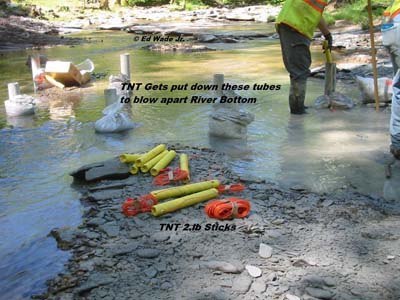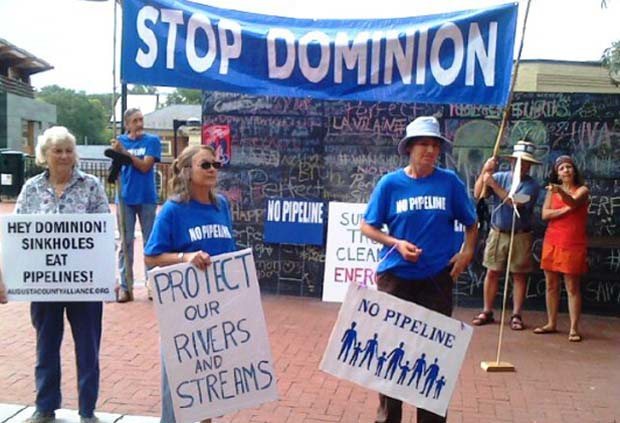The Atlantic Coast Pipeline is bigger than the KeystoneXL Pipeline proposed from Canada to Texas. To get this monster worm 10-feet underground, the bedrock of the most pristine remaining native brook trout streams in the East would be dynamited
By Chris Bolgiano / Multiple Sources
[dropcap]B[/dropcap]urrowing beneath the skin of the Earth all across the United States, new oil and gas pipelines are erupting in a rash of environmental destruction. More than 20,000 miles of new pipelines were built between 1998 and 2008, and tens of thousands more are under construction or proposed. Extreme energy extraction through hydraulic fracturing (fracking) for shale gas and oil demands extreme infrastructure support. Leaving soil-bleeding scars as they excavate ever forward, these pipelines are subsidized by taxpayer dollars but designed for corporate profits.
The Atlantic Coast Pipeline (ACP) would be one of the most destructive if it is allowed. Proposed in July 2014 by Dominion Resources with several other corporate partners, the ACP would cross 550 miles from West Virginia through Virginia to North Carolina, and cut through the healthiest, unfragmented woodlands in the eastern United States in the George Washington and Monongahela National Forests. Both of these forests have many areas full of uncommon plants and animals and are designated on state and international levels as “biodiversity hot spots.”
The ACP would also cross the Blue Ridge Parkway, Appalachian Trail, the Great Eastern Trail, and other unique and nationally treasured places on national park and forest lands

Dominion’s Atlantic Coast Pipeline eliminates another trout stream. This one in Virginia. An Ed Watts photo.
Ignoring landowner rights as well as environmental constraints, the ACP would run through some of the most productive and pastoral private farmlands in three states and pass close to numerous houses and communities.
Just as fracking is not like the hole-in-the-ground gas wells of the past, these new pipelines are not like the 300,000+ miles of pipelines already buried over past decades. At 42-inches in diameter, the Atlantic Coast Pipeline is bigger than the KeystoneXL Pipeline proposed from Canada to Texas.
To get this monster worm 10 feet underground, the bedrock of the most pristine remaining native brook trout streams in the East would be dynamited. The many seeps, springs and tiny rivulets that merge into headwater drinking rivers for millions downstream would be ripped apart and stitched roughly back together with permanent changes in terrain.
The sedimentation rate, a basic metric of stream health, would elevate dangerously, perhaps fatally. Several dozen steep mountain slopes would slump after being sliced and diced by bulldozers, like sunken cheeks on an invalid.
A 100-foot-wide permanent scar of grasses would replace the former forest, maintained with chronic disturbance along the parallel road necessary for pipeline monitoring and maintenance.
The endemic salamander species for which the Appalachian Mountains are famous, as well as many other small animals, cannot cross such open areas, but nonnative invasive species are attracted to them. In such ways are landscapes all along pipeline routes infected and degraded.
Confidence in Dominion’s ability to meet the extreme challenges of pipeline scale construction that few others have attempted is challenged by Dominion’s own record
The company is currently answering to multiple charges of water quality violations from pipeline leaks and erosion in West Virginia.
The arguments in support of these new pipelines are like home remedy myths: They persist despite scientific facts. Contrary to claim, fracked gas is not less carbon intensive than coal when full lifecycle counts are made, and could be worse.
Pipelines may indeed be, as claimed, safer than truck or rail transportation, but that’s not saying much for the nearly 500 people killed, more than 4,000 injured, and nearly $7 billion in property damage from pipeline breaks and explosions since 1986. And these new pipelines will further facilitate fracking, with its increasingly well-documented harm to health, especially reproductive health, as well as explosions, leaks, spills and emissions.
Attempts to regulate fracking, and to make pipelines safer, are desperate remedies by citizens, a classic case of treating the symptoms and not the cause of the illness
Our communities — and landscapes — don’t need more pipelines. We need Dominion to divert that $5 billion ACP investment into its recently purchased offshore wind lease and its anemic solar program. Good models of investing in renewable energy sources are available, like New Jersey’s Solar 4 ALL program, and the Cape Wind offshore project in Massachusetts. We need county and state policies that encourage utilities to transition to renewables and help people and businesses install distributed rooftop solar systems. Resulting jobs would be more abundant, local and long-lasting than pipeline construction.
Like parasitic worms, pipelines are eating through some of our nation’s most precious reserves of good ecological health. The best medicine is a big dose of reality: Parasites always weaken and sometimes kill their hosts.
About Chris Bolgiano
Chris Bolgiano’s third book, Living in the Appalachian Forest: True Tales of Sustainable Forestry, was recently published by Stackpole Books.


